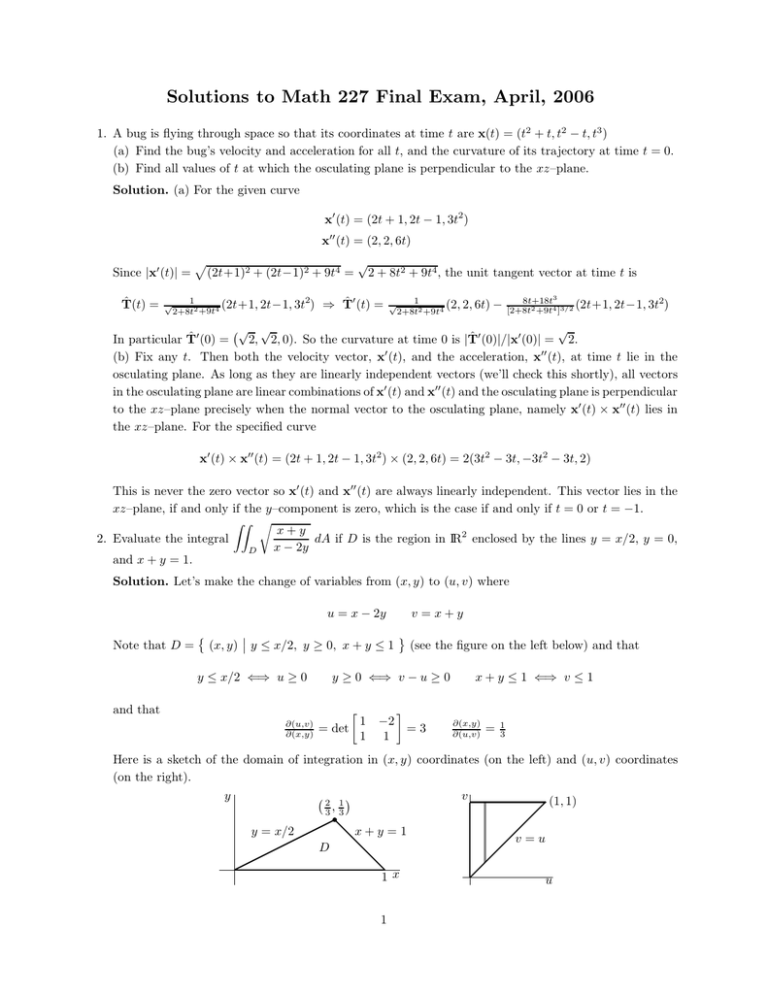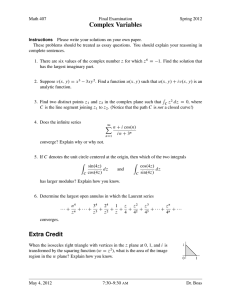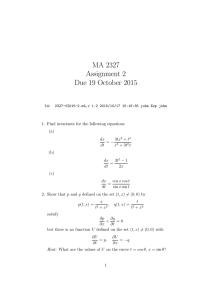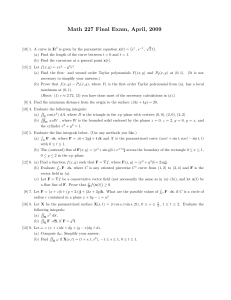Solutions to Math 227 Final Exam, April, 2006
advertisement

Solutions to Math 227 Final Exam, April, 2006 1. A bug is flying through space so that its coordinates at time t are x(t) = (t2 + t, t2 − t, t3 ) (a) Find the bug’s velocity and acceleration for all t, and the curvature of its trajectory at time t = 0. (b) Find all values of t at which the osculating plane is perpendicular to the xz–plane. Solution. (a) For the given curve x′ (t) = (2t + 1, 2t − 1, 3t2 ) x′′ (t) = (2, 2, 6t) Since |x′ (t)| = T̂(t) = √ p √ (2t+1)2 + (2t−1)2 + 9t4 = 2 + 8t2 + 9t4 , the unit tangent vector at time t is 1 (2t+1, 2t−1, 3t2) 2+8t2 +9t4 ⇒ T̂′ (t) = 2 1 8t+18t3 √ (2, 2, 6t) − [2+8t 2 +9t4 ]3/2 (2t+1, 2t−1, 3t ) 2+8t2 +9t4 √ √ √ 2, 2, 0). So the curvature at time 0 is |T̂′ (0)|/|x′ (0)| = 2. In particular T̂′ (0) = (b) Fix any t. Then both the velocity vector, x′ (t), and the acceleration, x′′ (t), at time t lie in the osculating plane. As long as they are linearly independent vectors (we’ll check this shortly), all vectors in the osculating plane are linear combinations of x′ (t) and x′′ (t) and the osculating plane is perpendicular to the xz–plane precisely when the normal vector to the osculating plane, namely x′ (t) × x′′ (t) lies in the xz–plane. For the specified curve x′ (t) × x′′ (t) = (2t + 1, 2t − 1, 3t2 ) × (2, 2, 6t) = 2(3t2 − 3t, −3t2 − 3t, 2) This is never the zero vector so x′ (t) and x′′ (t) are always linearly independent. This vector lies in the xz–plane, if and only if the y–component is zero, which is the case if and only if t = 0 or t = −1. ZZ r x+y 2. Evaluate the integral dA if D is the region in IR2 enclosed by the lines y = x/2, y = 0, x − 2y D and x + y = 1. Solution. Let’s make the change of variables from (x, y) to (u, v) where u = x − 2y Note that D = v =x+y (x, y) y ≤ x/2, y ≥ 0, x + y ≤ 1 (see the figure on the left below) and that y ≤ x/2 ⇐⇒ u ≥ 0 and that ∂(u,v) ∂(x,y) y ≥ 0 ⇐⇒ v − u ≥ 0 1 −2 = det =3 1 1 x + y ≤ 1 ⇐⇒ v ≤ 1 ∂(x,y) ∂(u,v) = 1 3 Here is a sketch of the domain of integration in (x, y) coordinates (on the left) and (u, v) coordinates (on the right). y 2 1 3, 3 y = x/2 v x+y =1 D 1x 1 (1, 1) v=u u So, switching to (u, v) coordinates ZZ r x+y dA = x − 2y D Z 0 1 du Z 1 1 3 dv u q v u = 1 Z 1 3 v=1 √1 2 v 3/2 u 3 v=u du 0 = 2 9 Z 1 du 0 √1 u − u = 92 2 − 12 = 1 3 3. The following integral is given in cylindrical coordinates: Z 2π Z 0 1 √ 4−r 2 Z r dzdrdθ √ r 3 0 Sketch the region of integration. Convert the integral to equivalent iterated integrals in (a) Cartesian coordinates, (b) spherical coordinates. Evaluate the easiest of the three integrals. Solution. The two outer integrals tell us that θ runs from 0 to 2π and r runs from 0 to 1. So (x, y) runs over the unit disk x2 + y 2 ≤ 1. The innermost integral tells us that, at any point on the disk, z √ √ √ runs from r 3 to 4 − r2 . So the bottom of the region of integration is the cone z = r 3 and the top is the sphere x2 + y 2 + z 2 = r2 + z 2 = 4. Here is a sketch of the part of the solid in the first octant. The √ top x2 + y 2 + z 2 = 4 intersects the bottom z 2 = 3(x2 + y 2 ) on the circle z = 3, x2 + y 2 = 1. z (0, 0, 2) x2 + y 2 + z 2 = 4 √ (0, 1, 3) √ (1, 0, 3) 3(x2 + y 2 ) = z 2 y x (a) Z 1 Z 2π dx −1 (b) √ Z dθ dy √ √ − 1−x2 Z 1 dR 0 0 Z √4−x2 −y2 1−x2 dz 3(x2 +y 2 ) Z π 6 dφ R2 sin φ 0 We evaluate the integral using spherical coordinates. Z 0 2π Z 0 1 Z √ 4−r 2 √ r 3 r dzdrdθ = Z 2π dθ Z 0 0 = [2π] 8 3 2 dR Z [1 − cos π 6 2 dφ R sin φ = 0 π 6] = 16π 3 1− √ 3 2 Z 0 2π dθ Z 0 2 dR R 2 Z 0 π 6 dφ sin φ R 4. Evaluate x F · ds, if F = sin y ı̂ + (x cos y − cos z)̂ + y sin z k̂ and x is the parametrized curve πt π 2 3 2 sin 2 , πt , πt ), 0 ≤ t ≤ 1. (Hint: this can be done without any complicated calculations.) Solution. Observe that F = ∇ϕ with ϕ = x sin y − y cos z. Hence, as the curve runs from (0, 0, 0) to π 2 , π, π , Z h i( π2 ,π,π) =π F · ds = x sin y − y cos z (0,0,0) x 2 5. (a) Evaluate ZZ S1 F · dS, if F = ex+y ı̂ − ex+y ̂ + 2z k̂ and S1 is the disc x2 + y 2 ≤ 9, z = 3, oriented so that the normal Z Z vector points upward. F · dS, if F is as in (a) and S2 is the part of the sphere x2 + y 2 + (z − 3)2 = 9 that lies (b) Evaluate S2 above the plane z = 3, oriented so that the normal vector points upward. (Hint: use the Divergence Theorem.) RR RR RR RR Solution. (a) S1 F · dS = S1 F · (k̂dxdy) = S1 2z dxdy = 6 S1 dxdy = 54π. p (b) Denote by V = (x, y, z) 3 ≤ z ≤ 3 + 9 − x2 − y 2 the region between S1 and S2 . It is the upper half of a solid ball of radius 3. By the divergence theorem ZZZ ZZZ ZZ ZZ x+y 3 e − ex+y + 2 dV = 2 × 12 × 4π ∇ · F dV = F · dS = F · dS − 3 3 = 36π V V S1 S2 So ZZ S2 F · dS = ZZ S1 F · dS + 36π = 54π + 36π = 90π 6. Let F = (x2 + 3y 2 z − 3z)ı̂ + 3x2 ẑ + (3y − x3 − y 3 )k̂. (a) Prove that (∇ × F) · dS = 0 everywhere on S, if S is the cylinder x2 + y 2 = 1 (with the normal vectorZ pointing outward). (b) Find C F · ds, if C is the oriented curve (cos t, sin t, sin t), 0 ≤ t ≤ π. (Hint: using Stokes’ theorem and part (a), reduce the problem to computing a simpler line integral.) Solution. (a) On the cylinder x2 + y 2 = 1 ı̂ ̂ k̂ ∂ ∂ ∂ ∇ × F = det = 3(1 − x2 − y 2 )ı̂ − 3(1 − x2 − y 2 )̂ + 6(x − y)z k̂ dx dy dz x2 + 3y 2 z − 3z 3x2 z 3y − x3 − y 3 simplifies to ∇ × F = 6(x − y)z k̂. Since the (outward pointing) normal vector to S has k̂ component zero, (∇ × F) · dS = 0 on S. (b) Let C ′ be the oriented curve (cos t, sin t, 0), 0 ≤ t ≤ π. Observe that both C and C ′ start at (1, 0, 0) and end at (−1, 0, 0). Let S ′ be the part of the cylinder S that is between C and C ′ . Then, by Stokes’ theorem ZZ Z Z (∇ × F) · dS = 0 F · ds = F · ds − S′ C′ C On C ′ , z = 0 so that F simplifies to x2 ı̂ + (3y − x3 − y 3 )k̂ and the k̂ component of ds is zero so that Z C F · ds = Z C′ F · ds = Z C′ x2 ı̂ · ds = Z 0 π π (cos t)2 (− sin t) dt = 13 (cos t)3 = − 32 0 7. Let X be the parametrized surface X(s, t) = (st, s + t, s − t), s2 + t2 ≤ 1. (a) Find Z the Z surface area of X. (b) Find (c) Find R X X F · dS, if F = (y + z)2 ı̂ + ŷ + z k̂. ω, if ω = (y − z) dx ∧ dz + x dz ∧ dy. Solution. (a) Since ∂X ∂s ∂X ∂t = t, 1, 1 = s, 1, −1 3 we have ∂X ∂s × ı̂ = det t s ∂X ∂t ̂ k̂ 1 1 = −2ı̂ − (−s − t)̂ + (t − s)k̂ ⇒ ∂X ∂s × 1 −1 ∂X ∂t = p 4 + (s + t)2 + (s − t)2 ) = p 4 + 2s2 + 2t2 Switching to polar coordinates s = r cos θ, t = r sin θ. surface area = ZZ s2 +t2 ≤1 = 2π × 2 3 × ∂X ∂s × 1 4 (4 + ∂X ∂t dsdt = r=1 2r2 )3/2 r=0 ZZ s2 +t2 ≤1 = π 3/2 3 [6 Z p 4 + 2s2 + 2t2 dsdt = 2π dθ 0 −4 3/2 ]= π 3/2 3 [6 Z 1 dr r 0 p 4 + 2r2 − 8] (b) Since F(X(s, t)) = (2s)2 ı̂ + (s + t)̂ + (s − t)k̂ and dS = − 2ı̂ − (−s − t)̂ + (t − s)k̂ dsdt, ZZ X F · dS = ZZ Z s2 +t2 ≤1 2π Z 1 − 8s2 + (s + t)2 − (s − t)2 dsdt = ZZ s2 +t2 ≤1 − 8s2 + 4st dsdt dr r[−8r2 cos2 θ + 4r2 cos θ sin θ] Z 2π Z 1 3 = dθ [−8 1−cos(2θ) + 2 sin(2θ)] dr r 2 = 0 dθ 0 0 0 = −8π × 1 4 = −2π (c) Since x(s, t) = st dx = tds + sdt y(s, t) = s + t dy = ds + dt z(s, t) = s − t dz = ds − dt we have ω = (y − z) dx ∧ dz + x dz ∧ dy = 2t(−t − s) ds ∧ dt + 2st ds ∧ dt = −2t2 ds ∧ dt and Z X ω = −2 ZZ s2 +t2 ≤1 2 t ds ∧ dt = −2 Z 0 2π dθ Z 0 1 dr r3 sin2 θ = −2 × π × 8. Decide whether the following regions are simply connected. (a) The complement of the line segment from (−1, 0) to (1, 0) in IR2 . (b) (x, y, z) ∈ IR3 1 ≤ x2 + y 2 + z 2 ≤ 9 1 4 = − π2 Solution. (a) is not simply connected since the circle x2 + y 2 = 2 can not be contracted. (b) is simply connected. Consider any closed curve in the set, which is a spherical shell. First move each point of the curve continuously radially outward to the sphere x2 + y 2 + z 2 = 9. Then poke a hole in the sphere at some point not covered by the curve. Think of the sphere as being made of rubber. Stretch the hole and flatten the sphere to form a disk. Then it is easy to contract the curve to the centre of the disk. 4




